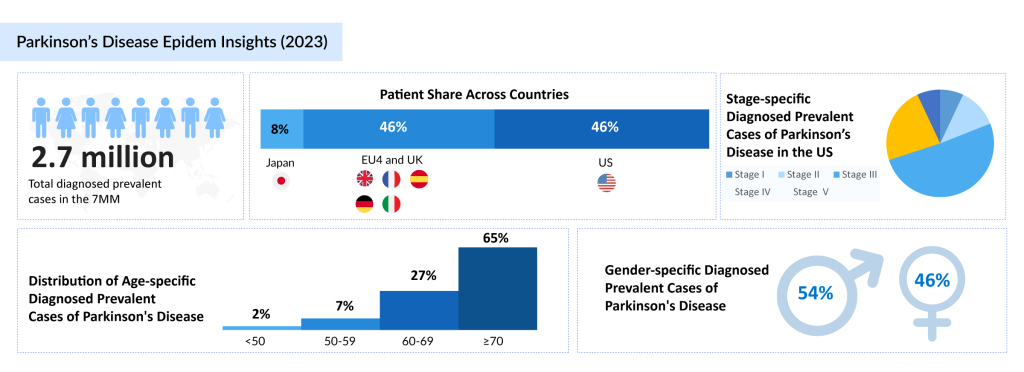Parkinson’s Disease: Impact of Emerging Therapies on the Therapeutics Market
Dec 24, 2024
Table of Contents
Parkinson’s disease is a complex neurodegenerative disorder that affects millions worldwide, with increasing prevalence as populations age. The market for Parkinson’s disease treatments is expanding rapidly, driven by rising awareness of what Parkinson’s disease is, advancements in research, and improvements in healthcare systems. In 2023, the United States Parkinson’s disease market size was USD 1.8 billion. This growth underscores the rising demand for therapies targeting both the symptoms and progression of the condition. Despite established treatments, significant unmet needs remain, particularly for therapies that address the underlying causes and improve life expectancy for Parkinson’s patients across all stages of Parkinson’s disease.
Emerging Parkinson’s disease therapies are reshaping the landscape, offering hope for more effective management of the condition and slowing its progression. These advancements aim to address critical aspects of Parkinson’s disease progression, including alpha-synuclein aggregation and mitochondrial dysfunction. The introduction of novel treatments, such as gene therapies and advanced drug delivery systems, aligns with the growing interest in understanding Parkinson’s disease and how to combat it. As the global population faces an increase in Parkinson’s disease cases, particularly in later stages, these innovations provide new opportunities to manage symptoms and improve quality of life. The evolving therapeutic pipeline reflects a significant shift in the approach to treating Parkinson’s disease, promising better outcomes for patients navigating the various stages of Parkinson’s disease progression.
Downloads
Click Here To Get the Article in PDF
Recent Articles
- Most Promising Therapies in the Parkinson’s Disease Treatment Market
- The Future of Parkinson’s Disease Treatment: Unlocking the Potential of Cell and Gene Therapy
- Evaluation of Rapidly Evolving Parkinson’s Disease Therapeutic Market
- Need of the Hour: Enhanced Strategies for PD-LID Treatment and Management
Parkinson’s Disease Market Dynamics
The Parkinson’s disease market is shaped by a combination of drivers, restraints, and opportunities that influence its growth and future trajectory.
Drivers: Increasing Prevalence of Parkinson’s Disease
Parkinson’s disease is becoming more prevalent globally due to aging populations and environmental risk factors. The increasing prevalence of Parkinson’s disease highlights the urgency to address this growing health challenge. The disease manifests with hallmark motor symptoms such as bradykinesia, rigidity, tremors, and postural instability, alongside non-motor symptoms like cognitive impairment and depression, which significantly reduce the quality of life. As the burden of Parkinson’s disease continues to rise, there is growing demand for effective treatments that address both motor and non-motor aspects of the condition.
Restraints: Availability of Alternative Treatments
Despite advancements in Parkinson’s therapies, the availability of alternative treatments poses a challenge to the market. Established pharmacological treatments like carbidopa/levodopa and formulations such as DUOPA and RYTARY offer reliable symptom management. Additionally, non-pharmacological interventions and surgical options like deep brain stimulation provide viable alternatives for many patients. These existing therapies, combined with their widespread use and familiarity among clinicians, can slow the adoption of newer treatments entering the market.
Opportunities: Patent Expirations of Existing Drugs
The impending patent expirations of several established Parkinson’s disease drugs create significant opportunities for the market. Generic versions of key therapies will not only make treatments more accessible but also open avenues for the development of novel drugs and improved formulations. Additionally, the robust pipeline of emerging therapies, including a-synuclein-targeting drugs, gene therapies, and regenerative approaches, promises to redefine the therapeutic landscape. Late-stage candidates such as SPN-830, tavapadon, P2B001, and ND0612 hold the potential to address critical unmet needs, particularly in motor symptom control and disease modification, marking a new era of innovation in Parkinson’s disease treatment.
Parkinson’s Disease Epidem Segmentation
The Parkinson’s disease market is segmented to provide a detailed understanding of the patient population and treatment needs across the 7MM (United States, EU4 countries, United Kingdom, and Japan) from 2020 to 2034.
Key categories include:
- Total Diagnosed Prevalent Cases
- Gender-Specific Cases
- Age-Specific Cases
- Stage-Specific Cases
- Psychosis Due to Parkinson’s Disease
- MCI Due to Parkinson’s Disease

This segmentation ensures a comprehensive view of the market, supporting tailored therapeutic strategies and forecasting.
Parkinson’s Disease Competitive Landscape
The Parkinson’s disease market is fiercely competitive, driven by the continuous pursuit of innovative solutions to address the unmet needs of patients. Established pharmaceutical companies, emerging biotechs, and research-driven organizations are actively contributing to the evolution of Parkinson’s disease therapies. The market is witnessing a surge in demand, fueled by advancements in treatment options, diagnostic techniques, and ongoing research.
New entrants, such as Sunovion and Accorda, are making strides in developing rescue medications aiming to cater to acute symptom management. Simultaneously, several companies are advancing pipeline drugs that target underlying pathologies and motor symptoms, seeking to fill gaps in the Parkinson’s disease therapeutic market. Emerging therapies, combined with state-of-the-art diagnostic tools, are set to transform the Parkinson’s disease therapeutic area, driving growth in the market.
Key Players in the Parkinson’s Disease Market
Major players dominating the Parkinson’s disease therapeutic market include GlaxoSmithKline plc, Teva Pharmaceutical Industries Ltd., Boehringer Ingelheim International GmbH, and AbbVie Inc. Companies like ACADIA Pharmaceuticals Inc., Novartis, Lundbeck, and UCB Biopharma SRL are also contributing significantly to the Parkinson’s disease market size through innovative products and therapies. Emerging players such as Annovis Bio, Pharma Two B, Supernus Pharmaceuticals, Mitsubishi Tanabe Pharma (NeuroDerm), and Cerevel Therapeutics, LLC are expected to influence the competitive landscape with novel therapeutic approaches.
Parkinson’s Disease Market Share Analysis
According to DelveInsight’s analysis, the Parkinson’s disease therapeutic market in 2023 was dominated by combination therapies and established medications, generating approximately USD 2 million in revenue. This significant market share reflects the reliance on proven pharmacological treatments, with an increasing focus on diversifying options through emerging therapies and personalized care solutions.
What’s New in Parkinson’s Treatment?
The Parkinson’s disease market has seen remarkable advancements in recent months. On November 1, 2024, Sunbird Bio announced groundbreaking diagnostic technology capable of classifying Parkinson’s-positive patients with 86% accuracy by detecting aggregated alpha-synuclein proteins. This innovation represents a major leap in early diagnosis, enabling timely and effective interventions.
Further expanding the Parkinson’s disease therapeutic area, Cerevance initiated its Phase 3 ARISE trial on November 18, 2024, dosing the first patient with solengepras, a novel adjunctive therapy designed for tailored intervention. This approach underscores the shift toward precision medicine in Parkinson’s disease therapies.
In December 2024, AbbVie revealed positive topline results from its pivotal Phase III TEMPO-2 trial evaluating tavapadon, a first-in-class D1/D5 partial agonist. As a flexible-dose monotherapy for early-stage Parkinson’s, tavapadon achieved both primary and secondary endpoints, promising to redefine the dopamine agonist market and further augment the Parkinson’s disease market size.
These advancements signify a rapidly evolving Parkinson’s disease therapeutic market, with ongoing innovations poised to reshape the treatment landscape and improve patient outcomes.
Future Outlook
The future of the Parkinson’s disease therapeutic market holds immense promise as research and innovation continue to push the boundaries of treatment possibilities. Pharmaceutical companies are shifting their focus toward developing therapies that not only manage symptoms but also target the disease’s underlying pathology. Advances in understanding mechanisms such as alpha-synuclein aggregation, mitochondrial dysfunction, and neuroinflammation are paving the way for disease-modifying treatments that could significantly slow or halt the progression of Parkinson’s disease.
Emerging technologies, including brain-penetrant drugs, gene therapies, and advanced delivery systems, offer the potential for greater efficacy and precision in managing the disease. Biomarker-driven approaches are set to revolutionize early detection and patient stratification, enabling tailored interventions that improve outcomes. With ongoing research into genetic factors and neuroprotective agents like GLP-1 agonists, new therapeutic strategies are poised to emerge, further enhancing care. Combined with a growing emphasis on holistic management, including dietary and lifestyle considerations, the future of Parkinson’s disease treatment promises a brighter outlook for patients navigating this challenging condition.

Downloads
Article in PDF
Recent Articles
- Need of the Hour: Enhanced Strategies for PD-LID Treatment and Management
- Evaluation of Rapidly Evolving Parkinson’s Disease Therapeutic Market
- Most Promising Therapies in the Parkinson’s Disease Treatment Market
- The Future of Parkinson’s Disease Treatment: Unlocking the Potential of Cell and Gene Therapy



